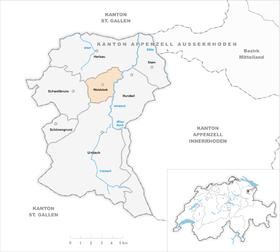Waldstatt
| Waldstatt | |
|---|---|
| State : |
|
| Canton : |
|
| District : | former Hinterland district |
| BFS no. : | 3007 |
| Postal code : | 9104 |
| UN / LOCODE : | CH WAD |
| Coordinates : | 739 379 / 246743 |
| Height : | 822 m above sea level M. |
| Height range : | 666–967 m above sea level M. |
| Area : | 6.75 km² |
| Residents: | 1870 (December 31, 2018) |
| Population density : | 277 inhabitants per km² |
| Mayor : | Gantenbein Andreas |
| Website: | www.waldstatt.ch |
|
Waldstatt |
|
| Location of the municipality | |
Waldstatt is a municipality in the hinterland of the canton of Appenzell Ausserrhoden in Switzerland .
Waldstatt lies in the middle of the square Herisau , Hundwil , Urnäsch and Schwellbrunn and is therefore the only municipality in the canton that does not border on any other canton.
history
In 1374 the settlement was called Ober Walstatt, in 1415 Wallstatt and belonged to the Rhode and Herisau parish and shared their political history. The church and poor manors were separated from Herisau in 1719, and Waldstatt gained its independence as an exception in Appenzell Ausserrhoden in the year before the church was built in 1720. The relocation of the important connecting road from St. Gallen to Toggenburg through Waldstatt instead of Schwellbrunn in 1789 gave important development impulses , and the hamlet subsequently developed into a village. Since 1919 the public tasks are taken over by the community and the local corporation; the latter is responsible for the water supply and waste disposal. In 1973 a Catholic church was built. The village first grew along the main traffic axes, after the Second World War quieter residential areas developed outside.
In addition to traditional cattle and dairy farming, textile trade and trade, weaving (around 1800 there were 400 looms) and later embroidery developed. The mining of peat and sandstone also had a certain importance. In 1792 a bath was opened in Unter-Waldstatt, and Waldstatt subsequently became a health resort. Spa tourism declined after World War II. In 1839 the station was built for the post express car that drove from St. Gallen to Uznach. In 1875 Waldstatt received a station on the railway line that led from Winkeln (St. Gallen) to Urnäsch. In 1880 the first centrifuge for cheese production was put into operation in Switzerland. A mechanical jacquard weaving mill was set up in 1890, and two mechanical weaving mills and an embroidery factory were built in 1908. In 1932 a swimming pool was built. From around 1935, the focus of employment shifted to processing wood, metal and plastic. In 1945 a metal die-casting and thermoplastic injection molding plant was founded, which is the largest employer in town. In 2005, agriculture accounted for 13 percent and industry for 52 percent of jobs in the community.
population
| Population development | |
|---|---|
| year | Residents |
| 1734 | 634 |
| 1800 | 1034 |
| 1850 | 983 |
| 1900 | 1483 |
| 1950 | 1544 |
| 1980 | 1440 |
| 1994 | 1715 |
| 2000 | 1710 |
| 2004 | 1516 |
| 2008 | 1544 |
| 2010 | 1772 |
| 2015 | 1835 |
Culture
Gidio
This custom is only practiced in Waldstatt and the neighboring town of Herisau . The Waldstätter Gidio is fundamentally different from the Herisauer. In Waldstatt, the Gidopfarrer is responsible for the implementation. A pretty big responsibility for the 8th grader. Every year on Ash Wednesday there is a large parade. The parade runs through the whole village. At the forefront, the Guggenmusik multi-purpose blaari really heats up passers-by on the roadside . Immediately afterwards the hearse follows, with it the deceased Gidohosenstoss, who dies of a different misfortune every year. This is followed by the motif wagons of the Waldstatt students. They bring up topics from the past year again. The move is rounded off with the common people. The move is supported by many tradespeople from Waldstatt , who hand the children some sweets . At the end of the day, when the moving community gathers again at the Schulhausplatz , the Gidopfarrer reads the Gido sermon.
New Year's Eve
Every year on December 31st and January 13th the New Year's Eve lice are on the way in Waldstatt . They can be viewed in several broom stains.
Cattle show
One autumn day, the Waldstätter cattle breeders present themselves from their best side. It's back to the cattle show. In the morning, the ranchers arrive with their cattle at the cattle theater. The animals were dressed up, all for the occasion. No sooner have all the farmers reached the cattle arena than the judges begin to evaluate the individual cows . These are awarded in the afternoon in different categories. At around 4 p.m. the farmers leave the cattle scene again.
Attractions
photos
Aerial photo by Walter Mittelholzer , 1923
Web links
- Official website of the community of Waldstatt
- Thomas Fuchs: Waldstatt. In: Historical Lexicon of Switzerland .
Individual evidence
- ↑ Permanent and non-permanent resident population by year, canton, district, municipality, population type and gender (permanent resident population). In: bfs. admin.ch . Federal Statistical Office (FSO), August 31, 2019, accessed on December 22, 2019 .
- ↑ Thomas Fuchs: Waldstatt. In: Historical Lexicon of Switzerland .
- ↑ Thomas Fuchs: Waldstatt. In: Historical Lexicon of Switzerland .








